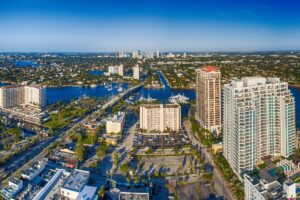Writer: Sara Suarez
 2 min read January 2022 — Over the past decade, Broward County has seen a steady increase in its number of residents year-over-year. While this has been objectively positive for the region, questions remain over how the county can continue to sustainably absorb the growth while navigating lingering challenges.
2 min read January 2022 — Over the past decade, Broward County has seen a steady increase in its number of residents year-over-year. While this has been objectively positive for the region, questions remain over how the county can continue to sustainably absorb the growth while navigating lingering challenges.
Christopher Lagerbloom, city manager for the City of Fort Lauderdale, spoke on this growth telling Invest:, ”We have seen more development now than we’ve seen before. We are seeing a tremendous amount of growth in our Downtown. The Downtown has proven to be quite the economic engine, with a lot of activity primarily in our urban core.”
The county is already densely populated, with 4,400 residents per square mile in urbanized areas and an average of 15,000,000 tourists visiting every year, according to Broward’s official website.
Many experts applaud dense cities with a big urban core because they shorten distances, are more sustainable, productive, and efficient. According to a scientific study by the American Economic Association, Broward is on the right track.
“The Greater Fort Lauderdale area in Broward County is going to be a more urban-centric environment. People are going to be living closer together. That’s going to be our environment,” Gregory Stuart, the executive director of the Broward Metropolitan Planning Organization told Invest: .
Two of the more pronounced challenges of high density areas are traffic congestion and elevated cost of living, of which Broward is feeling the effects of both. So, where does this triangle of economic prosperity, population growth, and land scarcity leave Broward? In a tough, but exciting, spot.
“We need to move people. We need to talk about roadway expansion and capacity expansion. It doesn’t happen on the surface anymore, so we are exploring different ways of moving and I firmly believe that the future of cities, the future of downtowns is underground and in the sky. That is how you are going to successfully move people. We need to figure out how to tunnel well and we need to start to talk about vertical takeoff,” Lagerbloom said.
The debate over which infrastructure solutions would better suit the county’s need as it pertains to alleviating traffic congestion has centered around constructing a tunnel or a bridge over or under the New River in Fort Lauderdale. A summary of the arguments from both sides looks like this: bridges disrupt, tunnels can flood, bridges are faster, tunnels more expensive, bridges destroy neighborhoods, tunnels and sea levels rising is a no-go. Government officials are still debating and looking at costs and environmental studies, and a solution to this debate will come in the following months, with construction expected to start in the coming years.
In regards to how the rising cost of living is being addressed, The Housing Authority of Broward is working on solutions to resolve affordability in the densely populated and almost entirely built-out downtown core.
Less than 1% percent of the land zoned for residential use is currently available in Broward. Out of the 1,323 square miles that make up the county, only 5 residentially-zoned miles remain vacant, according to a study by the Sun-Sentinel.
Rezoning is a fast, efficient solution. The 39.4-acre site at 4590 Peters Road in Broadview Park is the first rezoning project of 2022. Switching the zoning code from “R-5” to “R-16” will allow up to 630 to be built on the site, according to the South Florida Business Journal.
While the growth being experienced by Broward County has come with its challenges, optimism still abounds. “We have some challenges ahead… However, the opportunities far outstrip the concerns. It’s an exciting opportunity that is going to be life-changing for the good,” Stuart said.
